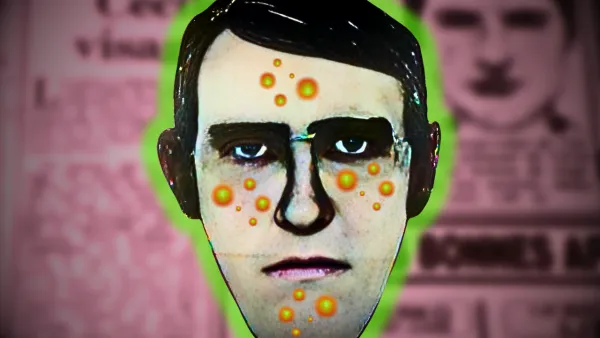The ‘Bitch of Buchenwald’ Enjoyed Making Lamp Shades… she made them from human skin.

The following article contains graphic descriptions and images of human torture and dismemberment pertaining to Nazi war crimes. Mature audiences only.
Unspeakable
The horrors and atrocities of WW2 have been well-documented by now, with Nazi criminals still being hunted even today. Many of the Nazi criminals sought by the War Crimes division worked in one or more of the over one thousand concentration camps, where evidence showed the systematic extermination of over one million Jews.
Some of the larger camps, i.e. Auschwitz, Dachau, and Treblinka, are well known, but fewer have heard of the camps that housed some of the most savage Nazi officials. One camp, particularly egregious, was Buchenwald, found five and a half miles northwest of Weimar.

It was here, where Ilse Koch, a red-headed, tall, and buxom female, rightly earned her name: “Die Hexe von Buchenwald”, or the “Bitch of Buchenwald” in English.
Gate To Hell
When Captain Frederick Keffer, an intelligence officer from the 6th Armored Division, led his band of American soldiers into the Buchenwald Concentration camp on April 11, 1945, the unspeakable horrors quickly overcame him and his men. Keffer spoke of the hundreds of emaciated “walking corpses”, so far past starvation that it was as if their bodies had already started to decompose. He writhed at the “mounds” of dead women and babies packed in the ditches and wagons. Their rotting limbs crisscrossing to provide the stable walkway used by the millions of maggots feasting on what flesh remained.

Many of the Captain’s men donned gas masks, but not because of a potentiality of chlorine gas, but to shelter their noses from the bitter smells of urine, feces, and death.
Author Flint Whitlock, in his historical account, The Beast of Buchenwald: Karl & Ilse Koch, Human-skin Lampshades, and the War-crimes Trial of the Century, described the death camp as “Dante’s Inferno, but without the compassion.”
Even General Patton, colourfully referred to as “Old Blood-and-Guts”, became violently ill after seeing the atrocities carried out on the inmates. Patton was so disgusted by Camp Buchenwald that he ordered the entire German town of Weimar, and all of its citizens, to take a full tour of the camp. This was not optional. Patton forced each Weimer citizen to look closely at the heinous activities their German neighbors have been heading for the last eight years.
Less Human Than Human
After arriving at the camp, “inmates” were given a number (seared into their skin with a needle and ink), and then photographed. Once these unfortunate humans were processed, the more sadistic SS guards would remind them of their position inside the camp. To do this, the guards would beat prisoners to death (or at least close to it), with their fist, sticks, metal dog leashes, nail-ridden clubs, rubber hoses, studded whips, shovels, rocks, or whatever else was handy.

The Boss
The SS officer in charge of the camp for the most of its existence was Karl Otto Koch. Karl Koch was born in Darmstadt on August 2, 1897, and he was one of two sons born to a bureaucrat. Koch’s father died when he was only six years old, so the young Karl and moved in to his mother’s new husband’s home with six other stepsons.

Many sadistic killers often experience physical, mental, and even sexual abuse as a child, but there is no evidence that Karl Koch or his wife Ilsa, both known for their savage killing and torture styles, were ever beaten or sexually assaulted as children. However, much of Karl Koch’s childhood remains unknown until his enlistment at seventeen into the German Army.
Karl Koch joined the Nazis on March 1, 1931 (member number 475,586) and was promoted quickly to the rank of second lieutenant. Soon after his promotion, he met Margarete Ilse Köhler, who soon became his wife, and to others, the most terrifying woman to ever exist.

Ilse Köhler, later known as the ‘Bitch of Buchenwald, was born on September 22, 1906, to Emil and Anna Köhler. Ilse’s father was a general laborer which meant her family struggled financially through childhood. Perhaps her life of poverty played a role in Ilse requiring the finest and rarest items in her adult life. The rarest being pocketbooks, notepads, and wallets fabricated with the tanned skin of a captured Jew.

Before meeting her husband, Ilse worked as a typist, secretary, and stenographer until she joined the Nazi party in 1932 (member number 1,130,863).
Ilse quickly became known as the “Die Hexe von Buchenwald” which translates in English to The Bitch of Buchenwald.
Joshua M. Green, author of Justice at Dachau: The Trials of an American Prosecutor, says of Ilse Koch:
“Ilse earned the nickname ‘Bitch of Buchenwald’ for her cruelty, wanton behavior, quixotic anger, and indifference to suffering.”
High Life
While thousands of Buchenwald prisoners were starving to death, Ilse was living the high life in the ‘Villa Koch’, the master home built on a nearby hill, which looked down inside the Buchenwald camp. Ilse had expensive fur coats, a cellar full of the finest wine, expensive dresses, and even an indoor horse riding arena that she could use if it was raining or cold outside.
Ilse is most infamous for her interest in making furniture out of the human skin of her prisoners. The most notable pieces of furniture were human skinned lampshades that would give as gifts to visiting SS officers.

It was also claimed that Ilse had her guards skin the prisoners to make book bindings, skin gloves, and purses.

There are even more macabre reports of human thumb light switches. One of Ilse’s favorite items to procure from human skin was lampshades, which she not only displayed in her villa, but also sent as gifts to the Nazi high command.
Several human furniture, such as chairs covering, were also found inside the Villa Koch and would be used during the Nuremburg trials as direct evidence of the horrors that happened inside the Buchenwald fence.

It’s interesting to know that Ed Gein, which I will be doing a multiple part series on (so please follow), enjoyed reading about the Nazi crimes, especially of Ilse Koch and the Buchenwald camp.
(Police removed from Gein’s dilapidated barn several human skin made items including: lampshades, nipple belts, skull cereal bowls, chair coverings, and even human lips attached to the cord pulling up or down the window blinds.)
Ilse Karma

You’ll be satisfied to hear that Ilse Koch was apprehended and prosecuted for her part in the terrors inside the Buchenwald death camp. She was restrained in a small cell in the Aichach prison near Dachau, where she hanged herself twelve years later. She was sixty years old.
Guards were relieved by her death, which finally brought silence to Ilse’s harrowing screams at night that reverberated through the thick concrete prison walls.
Her screaming was a nightly routine until she twisted her bedsheet around her own neck, which she then knotted around the non-working light fixture above her bunk.
Ilse screamed because “they” visited her each night, or at least she claimed. They, being the emaciated apparitions of victims longed deceased, filling up her cell at night. They never spoke to her, she said, but she could recognize many of the skinless faces, still void of lips and tongues from when they begged for their own deaths inside the camp she once paraded around.
As the story goes, Ilse Koch took her own life as she became more and more delusional, paranoid, and perhaps even ridden with guilt.
Perhaps her victims DID visit her each night, keeping her company before she finally set off to her final destination…
Hell.





